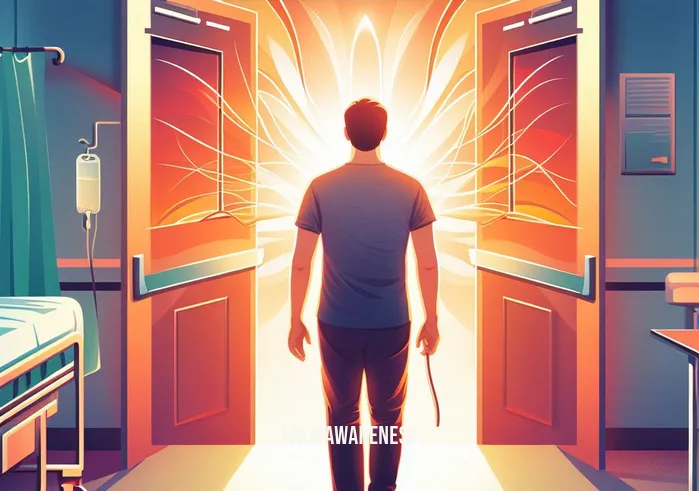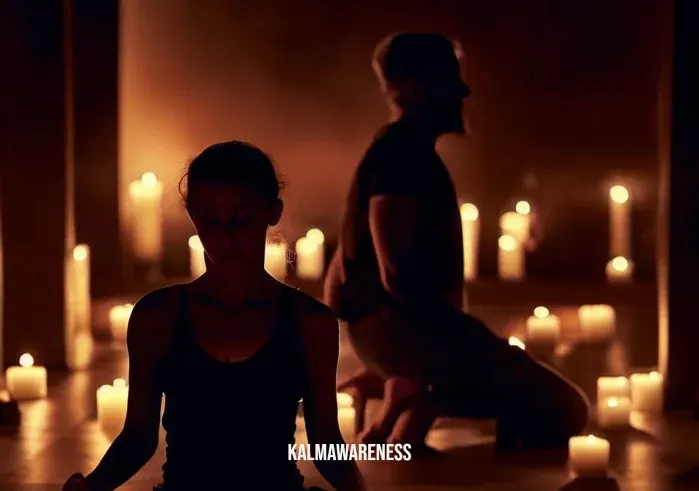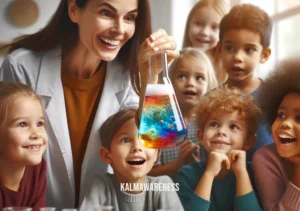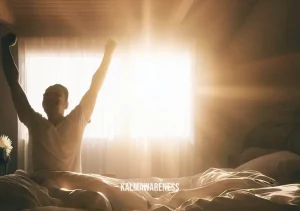Guided Imagery in Nursing: An Introduction
In today’s rapidly evolving healthcare landscape, professionals are consistently seeking integrative approaches to enhance patient care and wellness. One such approach, deeply rooted in the holistic healing philosophy, is the application of guided imagery in nursing. This practice, gaining recognition for its potency in stress management and pain management, is a testament to the profound mind-body connection that’s instrumental in healing.
What is Guided Imagery?
Guided imagery, at its core, is a focused practice that directs the imagination towards a relaxed, concentrated state. By creating a harmonious blend of vivid, positive images and experiences, patients are empowered to navigate their internal landscapes, thereby facilitating holistic healing. Essentially, it’s a form of mindful meditation tailored to meet specific needs. As Bruce Lee famously explored, the mind, when channelized correctly, can be an incredible force for rejuvenation.
Relevance in the Healthcare Sphere
The application of guided imagery in nursing is more than just an alternative practice; it’s a bridge that connects clinical care with holistic wellness. Nurses, often the frontline caregivers, hold a unique position. They can introduce patients to the soothing world of guided imagery, enabling them to tap into their internal healing mechanisms.
For instance, a study on mindful healing underscores how the process can potentially alleviate symptoms, reduce pain, and hasten recovery. Moreover, such techniques, when interwoven into the broader fabric of healthcare, advocate for a patient-centric approach, reminding us to always be patient with the healing journey.
Guided Imagery: A Response to Modern Stressors
Our modern environment, replete with myriad stressors, often places undue strain on both our mental and physical selves. Here, guided imagery emerges as a beacon of hope. It reminds individuals to breathe, to pause, and to recalibrate. For many, this is not just a technique; it’s a lifeline that anchors them, allowing for genuine introspection and stress relief.
Furthermore, the versatility of guided imagery ensures its applicability beyond just healthcare. Be it mindful dog training or crafting mindful software, the principles remain the same. It’s all about establishing a genuine connection with the present, understanding stimuli, and responding with awareness and intention.
Pain Management and The Power of the Mind
Chronic pain, a malady affecting millions globally, often becomes a formidable challenge for traditional medicine. Here, guided imagery in nursing introduces a paradigm shift. By harnessing the neuroplasticity and the power of mental force, patients learn to reconceptualize pain. Through visualization techniques, they can “redirect” neural pathways, enabling better pain management.
Such practices, whether it’s back pain meditation or understanding the spiritual meaning of lower back pain, provide individuals with tools. These tools, rooted in the age-old wisdom of the mind-body connection, usher in healing and relief.
Conclusion and the Path Forward
Guided imagery in nursing isn’t merely an adjunct therapy; it’s a revolution that’s redefining how we perceive healthcare. By marrying clinical precision with holistic practices, it promises a future where care is genuinely patient-centric, compassionate, and effective.
As we delve deeper into the subsequent segments, we’ll further explore the intricacies of guided imagery, its applications, and real-world examples that showcase its transformative potential. Whether you’re a healthcare professional, a patient seeking relief, or someone intrigued by the interplay between the mind and body, there’s a wealth of knowledge awaiting. Stay with us as we journey into the world of holistic healing, stress management, and the undeniable power of the mind in the next segment. Continue reading to embark on this enlightening voyage.

The Transformative Potential of Guided Imagery in Nursing
As we venture further into the realm of holistic healing, the prominence of guided imagery in nursing becomes even more evident. This therapeutic technique, rooted in the intricate tapestry of the mind-body connection, offers unparalleled benefits to both caregivers and patients. Here, we’ll delve deeper into the methodology, its nuances, and how it stands as an emblem of patient-centered care.
Guided Imagery: Beyond Surface-Level Understanding
Guided imagery isn’t just about visualization; it’s about immersing oneself in a multisensory experience, one that can bring about profound changes in physiology, emotion, and perception. It’s a testament to how our mental processes, when channelized aptly, can wield tangible healing benefits.
Mindful Attunement: Drawing parallels from practices like Teddy Bear Yoga, guided imagery in nursing calls for a form of ‘mindful attunement’. This implies a heightened sense of awareness, where one is attuned to internal and external stimuli, responding with intention rather than reaction.
A Safe Haven: Often, patients in distress seek refuge, a space devoid of pain, anxiety, or fear. Guided imagery creates this haven, where one can escape, recalibrate, and return rejuvenated. This process, as explored in mindful therapy practices, underscores the therapeutic potential of such interventions.
Evolving Practice: Just as we understand that the belly can rule the mind, the practice of guided imagery evolves. It adapts, transforming as per the needs, ensuring maximum therapeutic benefit.
Benefits of Guided Imagery in Nursing: An Overview
Incorporating guided imagery within the nursing paradigm offers a plethora of benefits, not just limited to pain management or stress relief. Here’s a table delineating some of the core benefits, methods, and outcomes of this practice:
| Benefit | Method | Outcome |
|---|---|---|
| Pain Alleviation | Deep Visualization | Reduced Pain Intensity |
| Stress Reduction | Breathing Techniques & Imagery | Lower Cortisol Levels |
| Enhanced Recovery | Positive Imagery & Affirmations | Quicker Post-Operative Recovery |
| Improved Sleep Quality | Progressive Relaxation & Imagery | Prolonged REM Sleep |
| Emotional Regulation | Anchoring Techniques & Visualization | Enhanced Mood and Emotional Stability |
Real-World Applications
Guided imagery isn’t a mere theoretical construct; its applications are seen in various real-world settings:
Post-Operative Care: A pivotal phase, where patients often grapple with pain, anxiety, and a gamut of emotions. Guided imagery, by fostering a sense of calm, can expedite the healing process.
Chronic Illness Management: For patients battling chronic ailments, guided imagery can be a source of solace. It helps in symptom management, emotional regulation, and improving overall quality of life.
Pediatric Care: Children, with their vivid imagination, are prime candidates for guided imagery. Be it for pain management, anxiety relief, or simple relaxation, it’s a tool that can work wonders, as indicated in practices like easing one’s pain.
Elderly Care: Aging, with its unique challenges, often requires interventions that are both therapeutic and comforting. Guided imagery, by bridging the gap between the physical and the psychological, serves as an effective tool.
Conclusion and Gearing Up for What’s Ahead
Guided imagery in nursing is more than just an adjunct practice. It’s a transformative tool, one that reshapes the landscape of patient care. By tapping into the vast reservoir of the mind, it offers solutions, relief, and, most importantly, hope.
As we transition to our next segment, get ready to immerse yourself even deeper. We’ll explore case studies, testimonials, and delve into the science underpinning this remarkable technique. The journey of understanding the holistic magic of guided imagery in nursing is far from over. Continue reading to further unravel the mysteries of the mind-body connection in the next chapter.

Guided Imagery in Nursing: The Beacon of Hope
Within the vast expanse of holistic healthcare, guided imagery stands tall as a beacon of hope. Its transformative potential not only reshapes the traditional care landscape but also kindles inspiration for countless healthcare professionals and patients alike. Drawing from real-life examples, resonant quotes, and the profound insights on the power of mental force, let us delve into the hopeful realms of guided imagery.
The Echoes of Inspiration
As the adage goes, stories illuminate the path. Here are some narratives that underscore the inspiring might of guided imagery in the domain of nursing:
1. Embracing the Mind-Body Connection:
Anna, a 45-year-old woman diagnosed with chronic lower back pain, often felt trapped within her discomfort. The spiritual implications of her pain only exacerbated her anguish. However, when introduced to guided imagery by her attending nurse, Anna felt a discernible shift. She began visualizing her spine as a sturdy, flexible tree, drawing strength from the earth and providing shelter. This powerful imagery not only alleviated her pain but also imbued her life with a renewed purpose.
2. Finding Solace Amidst the Storm:
James, a war veteran, grappled with PTSD. The cacophonous memories of the battlefield often left him in despair. On exploring the concept of the warrior brain, his nurse introduced him to guided imagery exercises. Visualizing himself as a calm, anchored ship amidst turbulent waters, James began finding solace, realizing that he could weather any storm.
Voices of Hope: Resonant Quotes
“The mind, once stretched by a new idea, never returns to its original dimensions.” – Ralph Waldo Emerson
This quote epitomizes the essence of guided imagery. Once individuals embrace this technique, their perception of pain, discomfort, or stress undergoes a paradigm shift, often leading to lasting therapeutic benefits.
“Imagination is the beginning of creation.” – George Bernard Shaw
In the context of guided imagery in nursing, this quote underscores the importance of imagination in forging a path to healing, recovery, and wellness.
“You can’t depend on your eyes when your imagination is out of focus.” – Mark Twain
Relevant to patients like Anna and James, this quote emphasizes the clarity that guided imagery can bring, sharpening the focus of one’s imagination to manifest therapeutic outcomes.
The Road Ahead: Setting the Stage for Guided Imagery in Modern Healthcare
Modern healthcare, with its intricate blend of technology and human touch, is gradually recognizing the immeasurable worth of methods like guided imagery. This is evident from the emerging mindful software tools and training modules tailored for healthcare professionals. Such advancements not only validate the technique’s efficacy but also herald a future where guided imagery is integral to patient care.
Towards the Next Horizon
The journey of understanding and appreciating guided imagery in nursing is akin to uncovering hidden layers of an intricate tapestry. Each layer, whether it’s the scientific rationale, the transformative potential, or the countless stories of hope, adds depth and nuance to our understanding.
As we transition to our next segment, be prepared to delve into the very heart of this practice. We will explore the scientific underpinnings of guided imagery, unearthing the neuroscientific and physiological mechanisms that make it so potent. Continue reading and embark on a journey that marries the art of imagination with the precision of science in the next chapter.
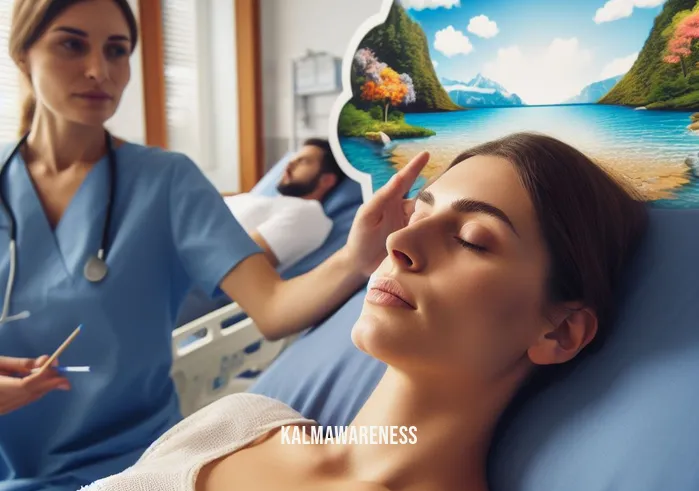
Guided Imagery in Nursing: The Nuanced Layers
Guided imagery, a powerful tool within the nursing realm, has been transforming patient experiences for decades. While we’ve journeyed through the inspirational stories and historical progression of this technique, it’s time to delve deeper into its intricacies. This chapter will unpack the layers, ensuring that every nurse or healthcare enthusiast grasps its foundational principles, methodologies, and its overarching benefits.
Foundational Principles of Guided Imagery
Mind-Body Cohesion: One cannot stress enough the intertwining relationship of the mind and body. The brain-heart coherence affirms that imagery isn’t merely a mental exercise but has palpable physiological repercussions.
Power of Visualization: At its core, guided imagery revolves around visualization. It’s not a passive daydream, but an active, intentional process. Just as Bruce Lee emphasized meditation for inner strength, visualization in guided imagery fortifies both mental and physical wellness.
Patient-Centric Approach: Every individual is unique, and so are their imagery techniques. It’s not a one-size-fits-all, but tailored to resonate with the individual’s personal experiences, beliefs, and aspirations.
Methods Employed in Guided Imagery
To make this therapeutic intervention more tangible, let’s enumerate some of the standard methodologies in the nursing sphere:
Progressive Relaxation: Gradually relaxing each muscle group, starting typically from the toes upwards.
Deep Breathing Techniques: Regular, deep breaths that increase oxygen supply, leading to relaxation. The philosophy that sometimes, we just need to remember to breathe, is central to this technique.
Thematic Visualization: Depending on the ailment or stressor, specific scenarios are visualized. For example, visualizing the immune system warding off pathogens for a patient with an infection.
Meditative Imagery: Incorporating aspects of doctor’s meditation, where patients are guided through peaceful scenarios, often nature-based, to instill calm and balance.
Unquestionable Benefits in Healthcare
Pain Management: Guided imagery has been pivotal in alleviating pain. Visualizing pain as a dimming light or a receding tide helps in lessening its intensity. A closer look at the back pain meditation can provide a more detailed understanding.
Reducing Anxiety and Stress: Imagery helps anchor patients, transporting them to serene landscapes, consequently reducing cortisol levels.
Enhancing Recovery: By visualizing the healing process, many patients have reported quicker recoveries post surgeries or treatments.
Boosting Immunity: A calm mind influences the body’s ability to heal and defend, indirectly bolstering immunity.
Improved Patient Compliance: A patient who is mentally at ease is more likely to comply with medical advice and medication regimens.
In Anticipation of the Conclusion
Guided imagery, as we’ve dissected, isn’t just an abstract concept. It’s a robust, scientifically-backed technique that’s been a linchpin in holistic healthcare. Its symbiosis with nursing has crafted countless success stories, many of which remain unsung.
As we transition to our final chapter, gear up to explore real-world applications, case studies, and the future trajectory of guided imagery in nursing. Prepare for a crescendo that ties together all the strings, providing a comprehensive view of this magnificent healing modality. Stay with us as we venture further in the next chapter.
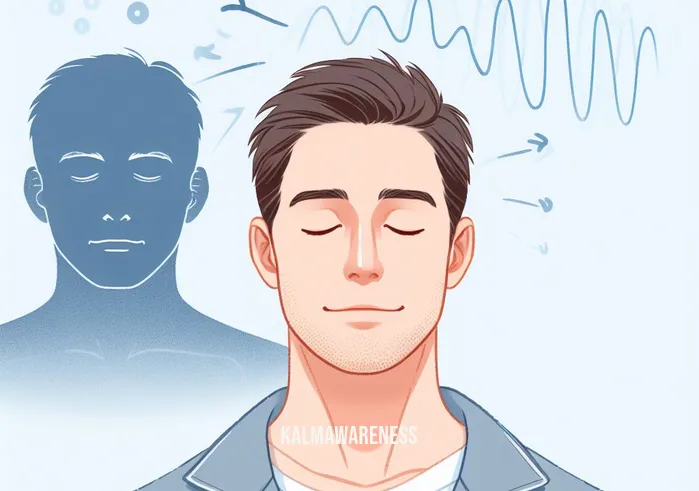
Guided Imagery in Nursing: Reflecting on a Transformative Journey
As we reach the end of this enlightening voyage through the world of guided imagery in nursing, it’s crucial to pause, look back, and internalize the knowledge gleaned. With the undulating currents of healthcare constantly evolving, the timeless essence of guided imagery stands tall, guiding countless souls towards holistic healing.
The Heart of Guided Imagery
Throughout our discussions, one truth became undeniably evident: guided imagery isn’t just a tool but an art, a dance between the conscious and the subconscious. It encapsulates the essence of the mind-body connection, acting as a bridge between tangible medicine and intangible healing forces.
The power of visualization, patient-centric approaches, and a cocktail of varied techniques collectively have revolutionized patient care. Drawing from the wisdom of mindful therapy, it’s become clear that the line dividing the mind’s prowess from the body’s responses is, indeed, very thin.
Journey’s Key Takeaways
Inclusivity in Healthcare: Guided imagery, with its versatility, can be tailored for anyone, regardless of age, cultural background, or personal beliefs. It’s healthcare at its most inclusive.
Stress and Pain Alleviation: Time and again, we’ve seen the wonders of visualization in pain and stress management, akin to the relief found in mindful dog training techniques that focus on calming and healing.
A Beacon of Hope: For those moments when medical jargon becomes overwhelming, and the path looks bleak, guided imagery has emerged as a ray of hope, grounding patients and offering solace.
Empowering the Patient: By encouraging active participation, patients are no longer mere recipients of care but pivotal contributors to their healing process.
Towards a Brighter Tomorrow
In the realm of healthcare, where both challenges and innovations are in constant flux, the perennial nature of guided imagery promises consistent comfort. It’s not just a methodology but a philosophy, one that emphasizes the harmony of mind, body, and spirit. With insights from sources like spiritual interpretations of pain, we’ve learned that every discomfort, every ailment, has layers beyond the physical.
Your Next Steps
Now that you’ve ventured deep into the world of guided imagery in nursing, the quest doesn’t end here. Our platform is brimming with resources, articles, and research to quench your thirst for knowledge. Perhaps starting with a piece on the spiritual significance of pain might be an intriguing next step?
However, if certain sections were complex or need revisiting, don’t hesitate. Circle back, reread, and re-engage. For knowledge is a spiral, and sometimes, revisiting the base strengthens the ascent.
A Heartfelt Thank You
Your time, your engagement, and your thirst for knowledge are truly cherished. We are endlessly grateful to have had you with us on this journey. And as we wrap up this chapter on guided imagery in nursing, remember, this isn’t a goodbye. It’s merely a ‘see you soon.’ The vast cosmos of holistic healing awaits, and we promise, our upcoming editions will have even more gems to share.
Thank you for joining us. Here’s to many more enlightening journeys together!
